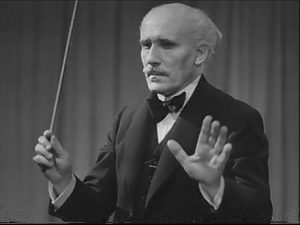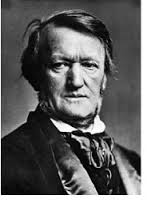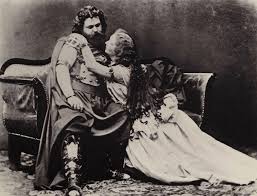Legends, Leitmotifs, and a Bit of Burlesque
Behind the Scenes – With A. C. Burch
Welcome to the first in a series of blogs sharing backstory and influences from A Book of Revelations.
In this series, I’ll describe the genesis of each story—hopefully without giving away too much. Each blog will feature one of Madeline Sorel’s original drawings as well as links to related content you may enjoy.
“Götterdämmerung” is one of the first short stories I ever wrote, and it remains a favorite. I think that’s because it recasts some of my musical experiences in a different medium. This tale of a concert violinist and his maestro has its origins in two distinct impressions. First, the memories of my favorite trumpet teacher and raconteur, John Coffey, and second, the operatic works of Richard Wagner, primarily Der Ring des Nibelungen (The Ring of the Nibelung), with a nod to Tristan und Isolde and Lohengrin.
John Coffey was plucked from the ranks of the orchestra at Radio City by Arturo Toscanini who asked him to join the famed NBC Symphony for a South American tour. John was an extraordinarily versatile musician who, at a later point in his career, alternated between performing with the Boston Symphony and playing in the pit orchestra for the “Old Howard” Theater in Boston’s Scullay Square. The Old Howard first opened in 1846, became a motion picture theater in 1912, and eventually became a burlesque house replete with striptease “artistes.” John often raced from one performance venue to the other, and to him, “it was all music.” I’ve always admired his down-to-earth view of the musical life. No snobbery with John. Never. It was John who told me an anecdote of Toscanini berating the entire orchestra for one musician’s mistake— how the temperamental maestro shamed his colleagues by saying, “part of me died today.” Who could resist including such drama in a story? Not this author.
One of John’s favorite anecdotes was how, during a rehearsal, Toscanini ruthlessly and continuously found fault with a flute player who finally cracked. Packing up and walking toward the exit, the musician turned and said, “You goddamn son-of-a-bitch, I hope you rot in hell.” Toscanini, whose English was not always the best, responded, “Is too late now for the apologies.” I still smile thinking of John’s telling of that story.
Between my orchestral and chamber work, I’m no stranger to the close calls that can occur during a performance. When an orchestra concert is going extremely well, something magical occurs. It’s as if the orchestra becomes a sentient being with its own will. Somehow, the minds (and hearts) of over one hundred musicians become as one, anticipating each other and coaxing each other on to even greater heights. It is this incredibly rare moment I find most rewarding. I’ve tried to portray near-disaster and sublime music-making in “Götterdämmerung.”
During the decades I performed, I sometimes played in opera orchestras. It was a different experience for me, used as I was, to sitting on stage in full view of the audience. Most opera pits were completely below the stage, much like they are for Broadway shows. Brass players often sat out long portions of the performance, only playing at certain dramatic points. Perhaps that’s why I liked Wagner so much, he used a lot of brass and wrote well for the instruments. Some of the operas in “The Ring” could run over five hours and were certainly an endurance test, but there were some juicy parts for the brass players that made it worth the wait.
For me, the weirdest part of playing in a pit was the sound of footsteps overhead. Some of the heftier singers clomped around the stage like Clydesdales. While that was distracting, there were other things going on that also took some getting used to. Hidden out of sight of the audience and having lots of time on their hands, the brass players would play tricks—slipping centerfolds from “girlie magazines” between the pages of a particularly shy clarinetist, or spraying the back of someone’s neck with a squirt gun just as they were to make an entrance. It was juvenile and certainly unprofessional, but it passed the time and in many cases brought us closer together.
A passionate love of the music of Richard Wagner, who still is a controversial figure, came out of these gigs. He wrote some horrible anti-Semitic rants, and when Hitler came to power, Wagner’s music—and family—were appropriated as totems of the Third Reich. I’ve always struggled to reconcile Wagner’s music with his politics. That struggle is also a part of the story.
Wagner used a technique known as Leitmotifs or, as Anna Russell called them, “signature tunes” to round out his drama in “The Ring.” There are motifs for nearly everything that appears more than once. In my story, named for the final opera in that cycle, I’ve tried the names of those that suited my narrative. To those of you reading this who are Wagnerians; enjoy the scavenger hunt!
Last of all, there’s the music itself. Translating sound into words was the most challenging and enjoyable part of writing this short story. There are three key pieces that frame the narrative: The Mendelssohn Violin Concerto, The “Prelude” and “Liebestod”—“Love Death”—from Tristan und Isolde and the “Prelude to Act III” of Lohengrin. Vintage performances of all three can be found by clicking this link, and scrolling down a page or so. You may enjoy listening to them as you read the particular section that describes them. I do recommend listening to the Lohengrin if nothing else, but also think you’ll enjoy the other video clips. Anna Russell’s “re-interpretation” of Wagner’s “Ring” is a classic.
One last personal note. . . While still in high school, I was on my way to Jordan Hall for an audition when a lens fell out of my glasses and shattered on the pavement. I somehow found the address and went through with it. I didn’t get the gig, but I used that moment in this story forty-five years later.
A. C. Burch is the author of The HomePort Journals. Visit ACBurch.com to connect. Visit the Amazon page for A Book of Revelations to look inside the book, and, if you like what you see, maybe even purchase it.
- A. C. Burch On Writing - December 15, 2017
- Join Me at the 2nd Annual Provincetown Book Festival Sept 15 & 16th 2017 - September 12, 2017
- Provincetown Heroes - May 28, 2017











I just knew your heart was in this wonderful story. It was amazing and my favorite! Besides loving the characters and their situations, it made me wish I knew more about classical music, especially Wagner. The history, as well as the music, is fascinating. (i’m also glad to learn that leitmotifs originally came from music. We used the term in literary discussion as well.)
Thanks. I had a lot of fun writing it and building in the leitmotifs. In a strange way, they helped drive the energy of the story. As always, I played recordings of the music as I wrote about it. So glad you enjoyed it.